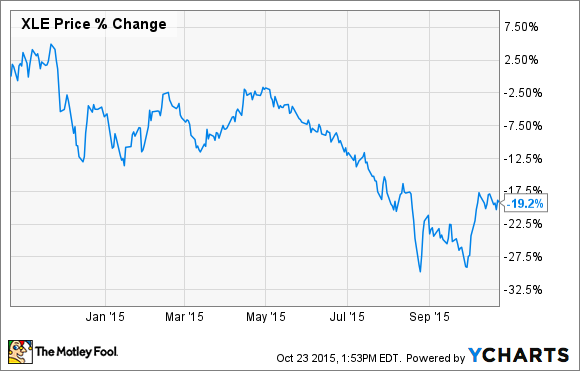If you're looking for stocks that are trading at cheap valuations, then today, the energy sector is probably the place to look. The decline in oil prices has taken just about every company in the sector with it. A quick glance at the SPDR Energy Sector Select ETF (XLE 0.51%) -- a proxy for the entire energy sector -- gives you an idea that there are a lot of companies on sale today.
We asked three of our contributors to highlight a company in the energy space that's declined more than 30% in 2015 but is worth a second look. Here's what they had to say.
Dan Caplinger
The energy bust has taken out companies throughout the industry, even though some of them arguably have more to gain now that prices of oil and natural gas have fallen so far. For Cheniere Energy (LNG 0.81%), there's been an intense debate about whether the prospects for exporting liquefied natural gas from U.S. sources will eventually prove profitable. Bulls argue that natural gas prices in some areas of the world are much higher than current U.S. prices, while skeptics respond that the same shale-gas techniques that the U.S. has pioneered will lead to other gas finds across the globe, removing the need for costly LNG transport.
Big-name investors have found themselves on opposite sides of this debate. Well-known activist investor Carl Icahn has taken a position in Cheniere, while well-known short-seller Jim Chanos has announced a short position in the stock. For those who are willing to be patient with a long-term investment decision, the fact that Cheniere has already secured contracts for much of its export capacity should offset concerns about macroeconomic weakness in key energy-consuming nations like China. Cheniere is far from a risk-free investment, but there's plenty of potential upside if things go right in the LNG market.
Tyler Crowe
Playing off of the LNG theme a little bit more, another aspect of the LNG trade that will need to ramp up is shipping. The argument could be made that international shale gas development might disrupt some of the anticipated demand for LNG, but based on the LNG outlook, there will still be plenty of the stuff that needs to be shipped.

Source: Chevron investor presentation.
With LNG shipping in high demand, one company that's worth looking at is Gaslog (NYSE: GLOG). The ships held by both the parent company and the ones it operates in its MLP subsidiary Gaslog Partners (NYSE: GLOP) have extremely strong contract coverage. More than 77% of the company's shipping days are covered by either firm contracts or charter options on those contracts all the way out to 2025.
Another component of these contracts and charters that's encouraging is that, once the BG Group merger is complete, all of its charters are for Royal Dutch Shell. Having a large, stable company like Shell -- a company with its own ambitious LNG plans -- as a customer greatly reduces counterparty credit risk, and greatly reduces the chance that those contracts won't get fulfilled.
One red flag for Gaslog is the high levels of debt at the parent company. The partnership-level entity still has a decent-looking balance sheet, and could probably alleviate some of that debt burden, but it's certainly something to keep an eye on during the next couple of quarters. If the company can continue to drop down chartered ships to the partnership, and grow out the fleet to meet the anticipated demand for LNG vessels without straining its finances, the 30% drop in Gaslog's shares will seem like a silly blip in a robust long-term run.
Adam Galas
The best part of my job is discovering new, high-quality, high-yield investment ideas to share with readers. Today, I'd like to point out EnLink Midstream Partners (NYSE: ENLK), which has been hammered far worse than either oil or other MLPs during the past year.
Based on the 8.6% yield and the 40% haircut the shares have taken this year, you'd think that this MLP's cash flows were extremely sensitive to commodity prices, and that its distribution-coverage ratio was so far below one, which would mean that its payout was unsustainable and about to be cut. In fact, 95% of its gross margin is fee-based, with 80% of its cash flow protected by either firm-transport agreements or minimum-volume commitments.
In terms of payout security, its three- and six-month distribution coverage ratios are 1.05 and 0.97, respectively -- perhaps not the most secure in the industry, but certainly not in danger of being cut.
In addition, EnLink's general partner, EnLink Midstream LLC, is 70% owned by Devon Energy Corp (DVN 0.43%), which serves both as EnLink Midstream Partners' largest customer and 29% equity owner.
The reason this matters is that EnLink Midstream's fortunes pretty much rise and fall with those of Devon; however, in 2016, Devon is completing two major midstream projects that it plans to drop down to EnLink Midstream Partners in order to help grow its distributable cash flow. This would secure its distribution and increase the amount of cash flowing back to EnLink Midstream LLC, as both regular distributions and incentive distribution, or IDR fees.
This will join the regular distribution cash flowing back to Devon Energy from its equity stake in its MLP, and help it ride out the oil storm.
The bottom line is that EnLink Midstream Partners' payout is much safer than its yield indicates, and its growth prospects -- courtesy of its strong relationship with Devon Energy -- are good enough to warrant income investors taking a closer look at this midstream MLP, especially at today's mouthwatering valuations.







